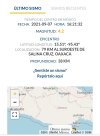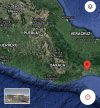Asteroid 2021 SG came from the sun’s direction
Asteroid 2021 SG: Bigger than Chelyabinsk
New-found asteroid 2021 SG is some four times larger than the 17-meter (18-yard) space rock that disintegrated over Chelyabinsk, Russia, on February 15, 2013. The
Chelyabinsk meteor created a shock wave that broke windows in six Russian cities. It caused some 1,500 people to seek medical attention, mostly from flying glass. But newly found asteroid 2021 SG didn’t hit. It just passed close, at only about half the distance from Earth to the moon, last week. Astronomers finally picked up the asteroid – discovering it for the first time – a day later on September 17, 2021. They were using a large telescope, the
48-inch (1.2 meter) telescope at Mount Palomar in California. Why didn’t they spot it sooner? Because it came from the direction of the sun.
An analysis of its orbit indicates that asteroid 2021 SG was closest to Earth on September 16 at 20:28
UTC (4:28 p.m. ET).
Asteroid 2021 SG has an estimated diameter of between 42 – 94 meters (138-308 feet). Its average diameter is 68 meters (223 feet). That’s in contrast to 17 meters for the Chelyabinsk meteor before it entered Earth’s atmosphere.
It came from the direction of the sun. Those words might sound chilling to you. And they do, too – perhaps more so – to scientists who work to detect near-Earth asteroids, in an effort to keep our planet safe. The Chelyabinsk meteor that did so much damage and caused so much consternation in 2013 also came, unexpectedly, from the sun’s direction. The fact is that astronomers have become very good at detecting near-Earth asteroids. And there are programs in place to watch for them. Some observatories constantly take images of the night skies in search for new asteroids. And astronomers feel they have a good handle on all the potentially damaging asteroids out there … except those that might come to us from the sun’s direction.
....



